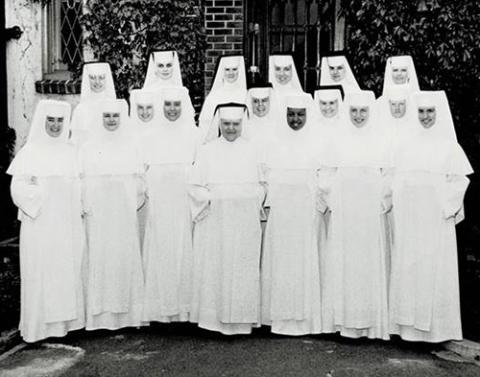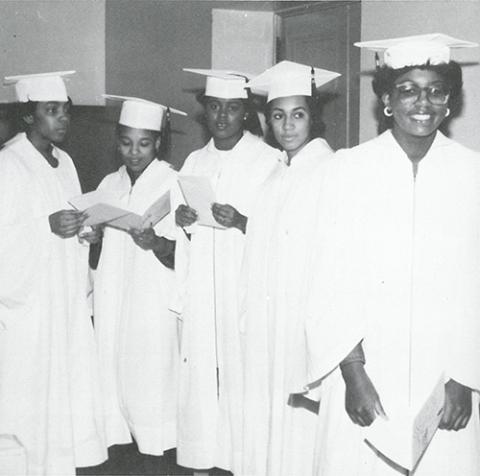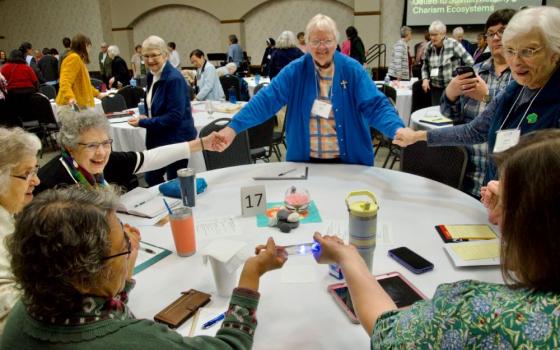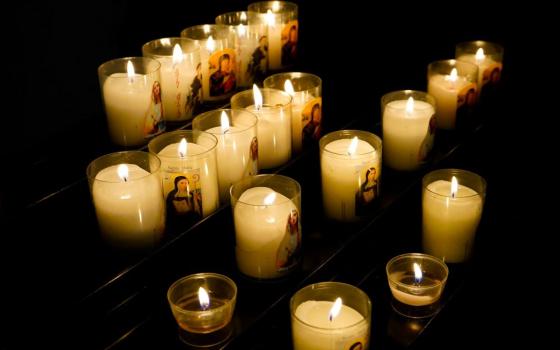
At the 2012 bicentennial of the Sisters of Charity of Nazareth, Kentucky, Sr. Theresa Knabel and sculptor Edward Hamilton unveiled a plaque honoring the enslaved people owned by the congregation until the end of the Civil War. (Courtesy of the Sisters of Charity of Nazareth)
An Adrian Dominican sister spent a year poring through the congregation's archives under the direction of the order's leadership team, trying to document a policy, a procedure, a decision — anything, really — that would show why the community had so few Black sisters.
She dug through more than 145 boxes of records but found nothing, not even statistics on how many Black women had tried to enter the community and either were turned away or changed their minds.
"To our credit or stupidity — or unconsciousness, probably — we didn't record people's race," Sr. Pat Siemen, the congregation's president, said of the 2018 document search. "We were more interested in whether people had a baptismal certificate than we were in their race."

Dominican Sisters of Edmonds celebrate the investiture of novices — including the congregation's first Black sister, Deanne (Martin de Porres) Gayle — and of first, renewing and finally professed sisters on June 14, 1964. The Edmonds congregation later merged with the Adrian Dominicans. (Courtesy of the Adrian Dominican Sisters)
Finally, two things became clear: The archives weren't going to yield what the leadership council was looking for, and there were a couple of numbers that were an inescapable truth beyond any statistics that old records might reveal.
"After 135 years — at one point, we had 2,500 sisters — we've had only six [professed] Black sisters in our history, and only two Black sisters today," Siemen said — four left the congregation after final vows. "There are certain obvious conclusions one comes to."
Congregations across the United States are undergoing similar examinations, spurred first by historian Shannen Dee Williams' address to the 2016 Leadership Conference of Women Religious assembly and with a new urgency after a police officer's murder of George Floyd in May 2020.
For many communities, sisters' efforts to eliminate racism are beginning by first addressing their own failures.
"We as women religious are absolutely called to this work. It's fundamental to who we say we are, and the first step is to revisit our history, all our collective history and our specific history," said Sr. Elise García, also an Adrian Dominican and the current LCWR president. "We have to admit and recognize the ways we have been complicit in this."
'These are sacred conversations we're being called to. This is going to take my lifetime. This is going to take generations.'
—Sacred Heart Sr. Maria Cimperman
García said her congregation realized that the archives were not going to produce some evidence of where they went astray.
"The numbers were not going to tell the story," she said. "The story was in our women. The story was in us."
That change in perspective also meant the sisters looked at the archives differently, and the records began to help tell the story by what wasn't there, like the fact that the 70 years of vocation brochures they found had almost no photos of women of color.
From the archives' photos and letters, the sisters learned that in addition to the four Black sisters who left, since 1945 at least another 83 women of color withdrew from the community. The reasons they gave included: "I felt avoided and intentionally excluded"; "[I] am not willing to become deculturated"; and "I do not trust the institution anymore, because there is not a guarantee that I will not feel mistreated, for reasons, I can only guess, such as racism."

Adrian Dominican Sisters pose with parishioners and priests of the Blessed Martin de Porres Mission in Fort Pierce, Florida, for a portrait in 1945. Despite arriving in the United States nearly a century earlier, this was one of the first times the Adrian Dominicans ministered to people of color. (Courtesy of the Adrian Dominican Sisters)
For much of the congregation's early history, the Adrian Dominicans likely wouldn't have come in contact with people of color because of America's racial segregation. The sisters arrived in the United States in the 1800s from Germany to serve German immigrants, and they later settled in rural southern Michigan, which was almost completely white. When their ministry expanded to other immigrant groups, those groups were also European.
In the early 1900s, they were called to staff schools in Cleveland and Chicago, but there were no children of color in the neighborhoods in which they ministered. They opened a school in Arizona that served Hispanic children, but the mission had been initiated to help the sisters sent there recover from tuberculosis. That they could also run a school was a bonus.
It wasn't until 1940 that the order had a mission dedicated to Black children, when it opened a school for Black students in West Palm Beach, Florida.
"We've always had some sisters highly conscious of racism, but it didn't necessarily go wider than those sisters already working in communities of color," Siemen said.
Until the social upheaval of the late 1960s, America's segregated society meant people of color were largely out of sight and out of mind for the Adrian Dominicans, a phenomenon that continues for most white people today.
At their 1968 chapter, the Adrian Dominicans added "racism" as one of their central issues to address. They were officially on the record saying fighting racism was important, but that didn't lead to much action.
LCWR begins the work
Likewise, Williams' 2016 address was the prelude to that year's conference resolution, which committed LCWR members to "examine the root causes of injustice, particularly racism, and our own complicity as congregations."
Williams, who by then had been working on a book — Subversive Habits: Black Catholic Nuns in the Long African American Freedom Struggle — for nearly a decade, postponed finishing it when at least five congregations opened their archives to her after the address. Others invited her to speak at their motherhouses so their sisters could learn their own histories. (Williams is on an extended sabbatical and could not comment for this story. Her book is scheduled to be published by Duke University Press in April 2022.)
Advertisement
Initially, LCWR's 2016 commitment for members meant LCWR itself began to work hard on the issue, said Sr. Patricia Chappell of the Sisters of Notre Dame de Namur, but she said she got the sense many congregations had other priorities. Chappell was executive director of Pax Christi USA for eight years and president of the National Black Sisters' Conference for five years. Now the co-coordinator of her community's anti-racism team, she has long been involved in anti-racism work, helping religious communities confront the systemic racism within their congregations.
But if little seemed to be happening at the congregation level, Floyd's murder in 2020 gave the effort an urgency unknown before, Chappell said, and since then, she has personally worked with 30 religious communities on their efforts to confront racism.
Sr. Jayne Helmlinger, a Sister of St. Joseph of Orange, California, and the current past-president of LCWR, said LCWR's presidential triumvirate had a phone call scheduled for the day after Floyd was killed.
"We had to set the agenda aside" because they could talk of nothing but Floyd's death and its implications, Helmlinger said. "I think that was the turning point."
Helmlinger said what made Floyd's death so pivotal for her was the realization that while white viewers of a viral video of his death were shocked, Black viewers were horrified but not surprised — Floyd's murder was just another example of a Black person being killed by police. Helmlinger said she and the others in leadership had to come to grips with the fear and trauma Black people are forced to live with every day, decade after decade.
"Suddenly, we were looking through a new lens," she said. "It felt very different and called for a response."

Graduates of Dominican High School in Detroit celebrate Ring Day in 1984. The high school, which closed in 2005, was a sponsored ministry of the Adrian Dominicans. (Courtesy of the Adrian Dominican Sisters)
LCWR officials contacted the National Black Sisters' Conference and asked for a partnership.
"We know it's our work to do, so we weren't asking the Black Sisters' Conference to step up and do the work," Helmlinger said. "We asked them to join us on our journey."
Sr. Josita Colbert, a Sister of Notre Dame de Namur and the president of the National Black Sisters' Conference, said LCWR is making great strides in its efforts and said she believes they will pay off, as any commitment has to start with the leaders.
"People have been responding and trying to be much more open," she said.
LCWR also hired Kathy Obear, a facilitator and the author of ... But I'm Not Racist!: Tools for Well-Meaning Whites, to help leaders in the organization confront their own racism.
"You can't [dismantle] organizational and institutional racism without doing the personal work," Helmlinger said. "I know it's changed me as a leader just as much as it's changed me as a human being."
Less than three months after Floyd's death, LCWR took the 2016 resolution a step further and called on members to join efforts to "name and eradicate racism within themselves, their congregations, their ministries, and LCWR as an organization."
The organization's members responded.
"For religious communities — primarily women, but a couple of men's communities, too — there is an openness to want to begin" this work, Chappell said. "The challenge and the difficulty is, how do you sustain the ongoing work that needs to be done?"
Some don't know where to start.
"There's a fear on part of many white sisters because they don't want to say the wrong thing or do the wrong thing," Chappell said. "So there's a fear of where do they begin."
Where to begin, many say, is to examine yourself, either as an individual or an organization or, preferably, both.

From left: Dominican Sr. Shawn Copeland, Dominican Sr. Jamie Phelps, Dominican Fr. Reginald Whitt, Dominican Sr. Maria del Rey Plain, Dominican Fr. Jerome Robinson and Dominican Sr. Cheryll Delahoussaye on the day of Copeland's final profession in 1977 (Courtesy of the Adrian Dominican Sisters)
"If you really understand what happened in the past, you can identify your previous behaviors and try to correct them," said theologian M. Shawn Copeland, a former Adrian Dominican. "And I think that's what sisters are after at this time."
'We have all benefited in the most terrible way'
Some congregations have already done a deep dive into their pasts despite knowing they would find the worst behavior imaginable: owning enslaved people.
In the fall of 2016, just weeks after Williams' address to LCWR and four months after The New York Times publicized the fact the Jesuits had owned enslaved people, the Society of the Sacred Heart, known as the Religious of the Sacred Heart, convened a committee to examine the society's role in racism and enslavement. The fact that the sisters had once owned 150 enslaved people wasn't hidden, but it also had not been looked at in detail. Until 2016, the community had no desire to open those books.
The Sacred Heart committee's work, which resulted in a 2018 gathering of descendants but still continues, came nearly two decades after a similar effort begun by three congregations in Kentucky that had enslaved Black people: the Sisters of Charity of Nazareth, the Sisters of Loretto, and the Dominican Sisters of St. Catharine. (In 2009, the Dominican Sisters of St. Catharine became one of the seven congregations that merged to form the Dominican Sisters of Peace.)

One of the few headstones naming the enslaved people buried in the cemetery of the Sisters of Charity of Nazareth, Kentucky. Though the people owned by the congregation were moved from a separate cemetery to the sisters' cemetery around 1912, most were placed in a common grave. (Courtesy of the Sisters of Charity of Nazareth)
In 2000, the three congregations gathered at a church in Bardstown, Kentucky, which had been built by enslaved people, and asked the descendants of the people they had owned for forgiveness.
That wasn't the first time the Sisters of Charity of Nazareth had gathered with the descendants. In 1912, 47 years after 30 people were emancipated from forced labor for the congregation — nine had already run away to join the Union Army in the Civil War — more than 150 people went to Nazareth for the congregation's centennial celebration, where the formerly enslaved people and their families were feted with tours, a big dinner and a dance.
"They maintained a relationship with the families over the years," said Sr. Theresa Knabel, who did extensive research on the congregation's slaveholding for its bicentennial in 2012. "It was a whole daylong celebration. ... They're still considered very much a part of us."
Congregations who owned enslaved people face a dilemma: How do they recognize and commemorate the work enslaved people did — work that often meant the survival of the congregation — while acknowledging that work only happened because they were held in bondage and treated as property?

People formerly enslaved by the Sisters of Charity of Nazareth, Kentucky, returned with their families to celebrate the religious order's centennial in 1912. The sisters say the people the congregation owned were considered family but acknowledge that in no way erases the sin of slavery. (Courtesy of the Sisters of Charity of Nazareth)
While Southern states did not recognize Black people owned as slaves as humans, meaning few official records exist, religious congregations, including the Sisters of Charity of Nazareth and the Society of the Sacred Heart, scrupulously kept sacramental records of baptisms and marriages.
The Nazareth sisters say there is no record their sisters bought or sold humans themselves: They were either given by the families of women entering the order or were born to people already enslaved there.
But "it doesn't undo the reality," said Sr. Adeline Fehribach, one of the Sisters of Charity of Nazareth's vice presidents. "It's like it never goes away. It will always be there."
For the Nazareth bicentennial in 2012, a plaque and monument to their forced work was dedicated, and a headstone with the names of the 28 buried there was placed. Knabel is now working on a permanent exhibit on that part of the congregation's history for the Heritage Hall in the motherhouse.

A headstone placed in the Sisters of Charity of Nazareth, Kentucky, cemetery in 2012 for the 28 enslaved people buried there (Courtesy of the Sisters of Charity of Nazareth)
Similarly, the 2018 event held by the Society of the Sacred Heart was planned by the descendants of the enslaved people. The family tree the sisters were able to build from their records was put online for anyone wanting to study the genealogy. New gravestones were installed and a plaque listing the names of those enslaved by the sisters was put on the former slave quarters, which still stand at the convent in Grand Coteau, Louisiana.
Sacred Heart Sr. Maria Cimperman was at the meeting where the decision was made to research the congregation's ownership of slaves.
"It was one of the most solemn gatherings I have ever been in," she said. "We have all benefited in the most terrible way from enslaved people's efforts. We're all beholden to them."
Before her congregation began its work, Cimperman was in Canada, working on that country's reconciliation efforts with the First Nations people over religious boarding schools, so she understood the research would only be the beginning of a long journey.
"These are sacred conversations we're being called to," she said. "This is going to take my lifetime. This is going to take generations. Right now, we can't talk across our divides. We need to recreate our structures."
That need to talk across divides took on more urgency after Floyd's murder, which led to "A Call to Transformative Love in Religious Life: Stories of Race, Place and Grace," an online event in three sessions in the fall that included Black religious telling the stories of what they went through when they joined white congregations, an examination of congregations that owned enslaved people, and how to transform congregations to be more welcoming. Cimperman is director of the Center for the Study of Consecrated Life at Catholic Theological Union in Chicago, which co-hosted the series with the National Black Sisters' Conference.
Floyd's death prompted Cimperman to ask herself what religious are called to do in the fight to dismantle racism. The answer, she said, was to begin by examining their own role in perpetuating it. Another set of online sessions in March included one titled "Owning Our History: Race and Racism in the History of the Catholic Church."
'If you really understand what happened in the past, you can identify your previous behaviors and try to correct them. And I think that's what sisters are after at this time.'
—M. Shawn Copeland
"We're still fighting over what's in our history books," Cimperman said. "Reconciliation is both a choice and a grace. It's different from forgiveness. I may forgive you but never again speak to you. But reconciliation is building a new relationship."
The need to see a new reality
Helmlinger used her presidential address at LCWR's August 2020 assembly to urge the organization's members to begin anti-racism work by looking within.
"This part of God's vision is infinitely clear to me: We have work to do, sisters, in our complicity in enabling the insidiousness of racism to flourish within and around us," she said in her remarks. "I cannot be, live or lead authentically if I'm not willing to do the inner work required in naming and eradicating the racism that dwells within."
She said she now knows this journey will take a lifetime.
"The unlearning is what's so surprising to me," she told Global Sisters Report. "It's not pointing a finger or shaming or anything else; it's understanding the true history of the United States. For most of us, [racism] wasn't out of malice; it was out of ignorance. I have to recognize that I look out of this white lens always."
'I cannot be, live or lead authentically if I'm not willing to do the inner work required in naming and eradicating the racism that dwells within.'
—St. Joseph Sr. Jayne Helmlinger
But Helmlinger, the other LCWR officers, staff, national board members and 15 regional chairwomen are learning to look through other lenses.
"It's painful work," she said, "but it's very gratifying work."
Margaret Susan Thompson, a historian at Syracuse University who studies Catholic sisters and race in the United States and is an associate with the Sisters, Servants of the Immaculate Heart of Mary, said history is controversial in the United States in ways it is not in other countries because of the ideals upon which the nation was built. Recognizing we have not always lived up to those ideals becomes an affront to the nation itself, she said.
"How do you have a document that says, 'All men are created equal,' written by a slave owner?" Thompson asked. "How is it a country built on these values wrote a Constitution that legitimized slavery?"
The same way the United States cannot address institutionalized racism if it will not recognize the history that created it, Catholic sisters will not be able to build relationships with Black communities if they will not acknowledge how they have hurt them, Thompson said.

Adrian Dominican Sr. Rosalie Esquerra teaches young adults in Life Directions, a peer-to-peer organization she helped found in 1973 to address violence, in the 1980s. Life Directions continues to serve at-risk youth in Detroit and Chicago. (Courtesy of the Adrian Dominican Sisters)
"They have to deal with their own histories to deal with the present," she said. "Often, they are histories of unconsciously racist attitudes. I think they were usually not actively discriminating. They were blind to things or oblivious to things, rather than acting with malice.
"But then, they have to ask: What would it take for us to really be different?" she continued. "I don't think there's a future for religious life unless it's a multicultural one. ... I think religious communities need to see a new reality, and that's a heck of a lot harder than just saying, 'We welcome Black applicants.' "
Colbert said Black sisters will only truly feel welcomed into a congregation if real change happens before they even apply. White communities need to embrace other cultures even when there isn't a representative to prod them, and they need to have Black speakers for topics other than racism.
'I don't think there's a future for religious life unless it's a multicultural one.'
—Margaret Susan Thompson
"They can't wait until a Black woman comes in and then put up a picture of Martin Luther King," she said. "It has to be part of who they are."
When a woman is called to join a congregation, Colbert said, that congregation — whatever its racial makeup — has an obligation to honor that, even if it means changing, because "it's God who calls us to religious life."
When the Adrian Dominicans' archive search was complete, the leadership team asked García to write the narrative of what they had found. She created a 55-page booklet, Reckoning With Racism: A Lenten Journey, in February that walked the entire congregation through the story of how they had built a community that welcomed so few Black sisters, sending those who read the booklet on their own personal journeys.
It's a journey in which the congregation cannot falter or slow down, Siemen said.
"This is part of our reckoning. We have to face the suffering we have caused others in order for there to be a commitment to change, in order to say, 'No more,' " she said. "Unless these stories get told, we will go on oblivious to the pain we are causing."






